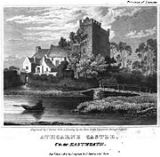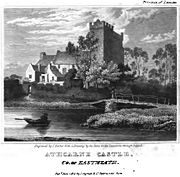
Duleek
Encyclopedia
Duleek is a town in County Meath
, Ireland
, close to the Louth border.
Duleek takes is name from the Irish
word daimh liag, meaning house of stones and referring to an early stone-built church, St Cianan’s Church, the ruins of which are still visible in Duleek today. The Duleek Heritage Trail has been conceived as a series of stepping stones through the village and its long and varied history.
In a poll carried out in March 2007 by national radio station Newstalk 106
, Duleek was voted Ireland's friendliest town.
 Duleek began as an early Christian
Duleek began as an early Christian
monastic settlement. St Patrick established a bishopric
here about 450 AD, which he placed in the care of St Cianan on November 24, 489. The place was sacked several times by the Norsemen
between 830 and 1149 and was also pillaged by the Normans
in 1171
. In April 1014 the bodies of Brian Ború
and his son lay in state in Duleek on their way to Armagh
.
The 12th century saw the reconstitution of the original monastery as St Mary's Abbey.
The first Norman
Overlord of Meath, Hugh de Lacy, established a manor and constructed a motte castle at Duleek. About 1180
he granted St Cianan's Church, together with certain lands, to the Augustinians
. The churchyard of the now disused Church of Ireland church occupies part of the site of the early monastery. The village’s four crosses and the lime tree on the village green are reminders of Duleek’s links to the struggle between William and James and to wider European unrest at the time of Louis XIV
of France
. One of the crosses, the Wayward Cross, was however erected in 1601
by Jane Dowdall in memory of her husband, William Bathe of Athcarne Castle outside the town. During World War II, or The Emergency, German bombers accidentally struck the village on January 1, 1941; minor damage was caused and there were no casualties.
County Meath
County Meath is a county in Ireland. It is part of the Mid-East Region and is also located in the province of Leinster. It is named after the ancient Kingdom of Mide . Meath County Council is the local authority for the county...
, Ireland
Republic of Ireland
Ireland , described as the Republic of Ireland , is a sovereign state in Europe occupying approximately five-sixths of the island of the same name. Its capital is Dublin. Ireland, which had a population of 4.58 million in 2011, is a constitutional republic governed as a parliamentary democracy,...
, close to the Louth border.
Duleek takes is name from the Irish
Irish language
Irish , also known as Irish Gaelic, is a Goidelic language of the Indo-European language family, originating in Ireland and historically spoken by the Irish people. Irish is now spoken as a first language by a minority of Irish people, as well as being a second language of a larger proportion of...
word daimh liag, meaning house of stones and referring to an early stone-built church, St Cianan’s Church, the ruins of which are still visible in Duleek today. The Duleek Heritage Trail has been conceived as a series of stepping stones through the village and its long and varied history.
In a poll carried out in March 2007 by national radio station Newstalk 106
NewsTalk 106
Newstalk is an Independent Radio station in Ireland. It is operated by News 106 Limited, a subsidiary of Denis O'Brien's Communicorp group, and broadcasts under a sound broadcasting contract with the Broadcasting Commission of Ireland.The station is a "quasi-national" station as of 29 September...
, Duleek was voted Ireland's friendliest town.
History

Christian
A Christian is a person who adheres to Christianity, an Abrahamic, monotheistic religion based on the life and teachings of Jesus of Nazareth as recorded in the Canonical gospels and the letters of the New Testament...
monastic settlement. St Patrick established a bishopric
Diocese
A diocese is the district or see under the supervision of a bishop. It is divided into parishes.An archdiocese is more significant than a diocese. An archdiocese is presided over by an archbishop whose see may have or had importance due to size or historical significance...
here about 450 AD, which he placed in the care of St Cianan on November 24, 489. The place was sacked several times by the Norsemen
Norsemen
Norsemen is used to refer to the group of people as a whole who spoke what is now called the Old Norse language belonging to the North Germanic branch of Indo-European languages, especially Norwegian, Icelandic, Faroese, Swedish and Danish in their earlier forms.The meaning of Norseman was "people...
between 830 and 1149 and was also pillaged by the Normans
Normans
The Normans were the people who gave their name to Normandy, a region in northern France. They were descended from Norse Viking conquerors of the territory and the native population of Frankish and Gallo-Roman stock...
in 1171
1171 in Ireland
-Events:*Death of Dermot MacMurrough.*Richard de Clare, 2nd Earl of Pembroke becomes lord of Leinster.*Henry II of England arrives in Ireland.*Submission of Irish bishops and most Irish kings....
. In April 1014 the bodies of Brian Ború
Brian Boru
Brian Bóruma mac Cennétig, , , was an Irish king who ended the domination of the High Kingship of Ireland by the Uí Néill. Building on the achievements of his father, Cennétig mac Lorcain, and especially his elder brother, Mathgamain, Brian first made himself King of Munster, then subjugated...
and his son lay in state in Duleek on their way to Armagh
Armagh
Armagh is a large settlement in Northern Ireland, and the county town of County Armagh. It is a site of historical importance for both Celtic paganism and Christianity and is the seat, for both the Roman Catholic Church and the Church of Ireland, of the Archbishop of Armagh...
.
The 12th century saw the reconstitution of the original monastery as St Mary's Abbey.
The first Norman
Normans
The Normans were the people who gave their name to Normandy, a region in northern France. They were descended from Norse Viking conquerors of the territory and the native population of Frankish and Gallo-Roman stock...
Overlord of Meath, Hugh de Lacy, established a manor and constructed a motte castle at Duleek. About 1180
1180 in Ireland
-Events:*Construction of Carrickfergus Castle begins.*St Mary’s Cathedral built in Limerick....
he granted St Cianan's Church, together with certain lands, to the Augustinians
Augustinians
The term Augustinians, named after Saint Augustine of Hippo , applies to two separate and unrelated types of Catholic religious orders:...
. The churchyard of the now disused Church of Ireland church occupies part of the site of the early monastery. The village’s four crosses and the lime tree on the village green are reminders of Duleek’s links to the struggle between William and James and to wider European unrest at the time of Louis XIV
Louis XIV of France
Louis XIV , known as Louis the Great or the Sun King , was a Bourbon monarch who ruled as King of France and Navarre. His reign, from 1643 to his death in 1715, began at the age of four and lasted seventy-two years, three months, and eighteen days...
of France
France
The French Republic , The French Republic , The French Republic , (commonly known as France , is a unitary semi-presidential republic in Western Europe with several overseas territories and islands located on other continents and in the Indian, Pacific, and Atlantic oceans. Metropolitan France...
. One of the crosses, the Wayward Cross, was however erected in 1601
1601 in Ireland
-Events:*30 November - Prince Hugh Roe O'Donnell, on his way to the Battle of Kinsale, visited and venerated a relic of the True Cross on the Feast of St. Andrew, at Holy Cross Abbey....
by Jane Dowdall in memory of her husband, William Bathe of Athcarne Castle outside the town. During World War II, or The Emergency, German bombers accidentally struck the village on January 1, 1941; minor damage was caused and there were no casualties.
Transport
Duleek railway station was opened on 1 August 1850, but was finally closed on 1 June 1958. Trains still operate through the old station between Drogheda and Tara Mines.See also
- List of towns and villages in Ireland

